Our Changing Earth: Virtual Bookshelf
The Virtual Bookshelf provides a list of recommended children’s books that reflect the theme of the issue and offers ideas on how to integrate them across the curriculum.
What do volcanoes have to do with Antarctica? That was my first question when I started working on this month’s bookshelf. It’s hard to imagine the hottest landform on earth located in the coldest region on earth, but there it is – Mount Erebus. The active volcano is located between the Scotia and Antarctic tectonic plates in the southernmost portion of the Ring of Fire.
Tectonic plates move slowly (at approximately the same speed as fingernails grow), but those few inches have great consequences. While elementary students aren’t ready to study the mechanisms behind plate tectonics, they can appreciate the effects: earthquakes, volcanoes, and slowly drifting continents.
Wind, water, and ice also play a role in changing and shaping Earth’s crust. Rock is broken down into sediments which are moved from place to place. Glaciers and the katabatic winds in Antarctica create unusual landforms in the polar regions.
In this month’s bookshelf, we’ve included books about erosion and glaciers, tectonics, earthquakes, volcanoes, and, of course, penguins and polar bears. As always, we focus primarily on nonfiction children’s literature to help students develop vocabulary and important reading comprehension strategies.
Erosion and Glaciers
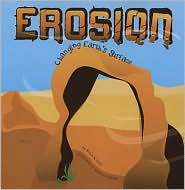 |
Erosion: Changing Earth’s Surface. Robin Koontz. 2007. Nonfiction book. Recommended ages: Grades 2-5.Volcanoes and earthquakes can change the surface of the earth in a few minutes or days, but erosion takes place each time it rains, each time an ocean wave crashes on a beach, and each time the wind blows across a desert. Glaciers also play a role in erosion by dragging and pushing soil, rocks, and even boulders over long distances. |
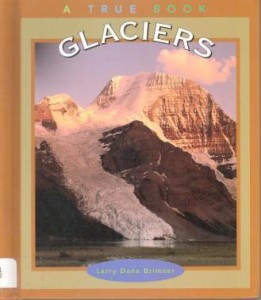 |
Glaciers. Larry Dane Brimner. 2000. Nonfiction book. Recommended ages: Grades 2-5.Who knew that tiny snowflakes could move mountains? They can over long periods of time. If snow does not melt, the layers eventually turn into huge ice sheets. The pressure from the ice sheet’s weight melts bottom layers, and the ice begins to move! This movement creates distinct landforms—horns, cirques, u-shaped valleys, and moraines. Photographs capture images of glaciers and each landform. |
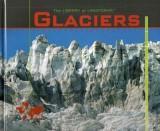 |
Glaciers. Isaac Nadeau. 2006. Nonfiction book. Recommended ages: Grades 4-5.Glaciers have had a huge impact on the earth’s landscapes. Throughout several ice ages, glaciers carved out valleys, flattened plains, and formed rivers and lakes as they melted. Today, glaciers only cover about 10 percent of the earth’s surface. This book explains the anatomy of a glacier, different types of glaciers, how glaciers move, and the landforms they create. |
Tectonic Plates
These books can be used to supplement the lessons and activities in “Teaching About Natural Resources and Energy Sources.”
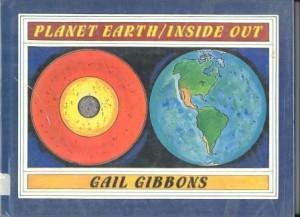 |
Planet Earth/ Inside Out. Gail Gibbons. 1995. Nonfiction book. Recommended ages: Grades 2-4.In typical Gail Gibbons fashion, this book offers simple explanations of plate tectonics and the resulting volcanoes and earthquakes. Colorful diagrams and illustrations show the types of faults and a cross-section of a volcano. There is also a brief discussion of how Earth formed, Pangaea, fossils, and types of rocks and minerals.
. |
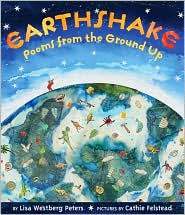 |
Earthshake: Poems From the Ground Up. Lisa Westberg Peters. 2003. Nonfiction poetry book. Recommended ages: Grades 3-6.Geology and descriptive language are married in this collection. “Continental Promises” is about Africa and South America saying goodbye as their tectonic plates carry them in different directions. “Wyoming Layer Cake” describes the spectacular sedimentary layers in the western United States. Illustrations complement the poems. |
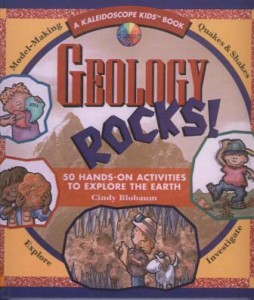 |
Geology Rocks! 50 Hands-On Activities to Explore the Earth. Cindy Blobaum. Nonfiction book. Recommended ages: Grades 1-5.The chapter titled Quakin’, Shakin’ and Shapin’ is filled with activities, facts, and diagrams to explain how our ever-changing earth works. A simple graham cracker and icing activity will help students understand faults. Create a seismograph with a rolling pin and a shoe box. Look at maps of volcanoes and earthquakes to discover that they go hand-in-hand. |
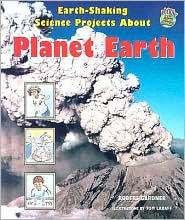 |
Earth-Shaking Science Projects About Planet Earth. Robert Gardner. 2008. Nonfiction book. Recommended ages: Grades 2-5.If you are tired of building volcanoes with baking soda and vinegar, you’ll love this book. Chapters 5-9 are filled with easy demonstrations that explain Pangaea’s separation, why plates move apart, what happens when plates come together, and how damage is effected in various locations related to the epicenter. |
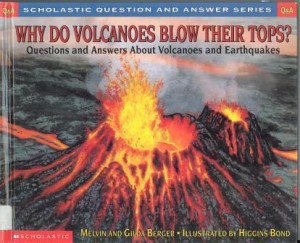 |
Why Do Volcanoes Blow Their Tops? Questions and Answers about Volcanoes and Earthquakes. Melvin and Gilda Berger. 1999. Nonfiction book. Recommended ages: Grades 3-5.Your students have lots of questions about volcanoes and earthquakes—and this book has the answers! Can people use volcanoes to keep warm? (Answer: Yes!) Where is the most dangerous volcano today? (Answer: Mount Popocatepetl because of its proximity to Mexico City.) Do all earthquakes occur along faults? (Answer: No. Sometimes they occur in weak portions of a plate.) These facts will enrich your unit on earthquakes and volcanoes. |
Volcanoes
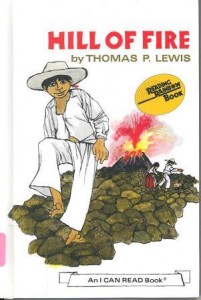 |
Hill of Fire. Thomas P. Lewis. 1971. Nonfiction easy reader. Recommended ages: K-2.
This book was featured on an episode of the Reading Rainbow television series. It is the story of a cinder cone volcano suddenly forming in the middle of a Mexican farmer’s field. The simple text is interesting enough to read aloud or to be read by students in the first or second grade. |
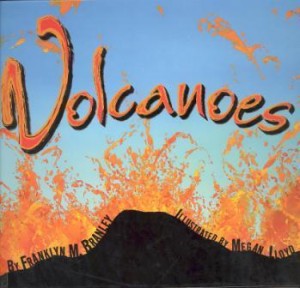 |
Volcanoes. Franklyn M. Branley. New edition 2008. Nonfiction book. Recommended ages: K-3.Part of the Let’s-Read-and-Find-Out-About-Science series. Simple text and bold illustrations tell of different types of volcanoes, how they form, and their effects on people and weather. This book would be perfect to pair with Hill of Fire because it mentions the cinder cone volcano in Paricutin, Mexico.
. |
Earthquakes
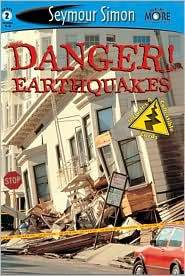 |
Danger! Earthquakes. Seymour Simon. 2002. Nonfiction easy reader. Recommended ages: Grades 1-3.The photos really make this book. Page after page of damage caused by earthquakes shows the power of plates moving against each other. Earthquakes rarely last more than a minute—but their effects can be devastating. The text in this book will be easy enough for many students to read alone, and they will learn the difference between the Richter and Mercalli scales. |
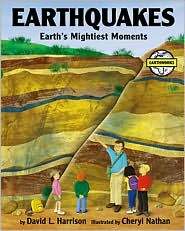 |
Earthquakes: Earth’s Mightiest Moments. David L. Harrison. 2004. Nonfiction book. Recommended ages: Grades K-2.Told in a picture book format, this story gives the most basic explanation for the composition of the earth, plate movement, and the resulting earthquakes and damage. Vivid illustrations make the book perfect for sharing.
. |
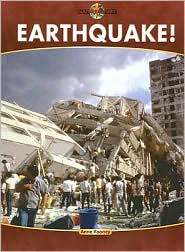 |
Earthquake. Anne Rooney. 2006. Nonfiction book. Recommended ages: Grades 4-5.Part of the Nature’s Fury series, this book gives a detailed explanation of earthquakes and plate tectonics. It explores different types of faults and the difference between surface and body waves. Social aspects of earthquakes are also discussed, such as location (cities versus countryside), rescuers, emergency relief, and rebuilding.
. |
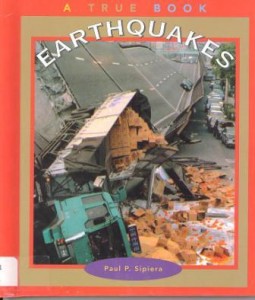 |
Earthquakes. Paul P. Sipiera. 1998. Nonfiction book. Recommended ages: Grades 3-5.Six chapters show how our planet’s composition relates to plate movement and earthquakes. The effects of quakes, such as structural damage, fires and tsunamis, are discussed along with technology that may help us predict their movement. This book is part of the True Book series.
. |
Penguins and Polar Bears
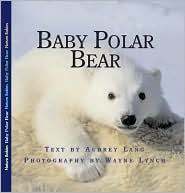 |
Baby Polar Bear. Aubrey Lang. 2008. Nonfiction book. Recommended ages: Grades K-3.Follow a typical polar bear family through the birth of cubs, walking from the interior to the sea ice, hunting for food, swimming lessons, and more. The pictures will make you want to cuddle with these soon-to-be giant (and dangerous) polar bears. |
 |
My Season With Penguins. Sophie Webb. 2000. Nonfiction journal. Recommended ages: Grades 4-5.Traveling to Antarctica to study penguins takes more than just a plane ride and a camera. Follow biologist Sophie Webb as she chooses cold weather clothing, attends survival school, and sets up a camp at Cape Royds (within view of Mount Erebus). Here she studies the Adelie penguins for two months. She explains methods for tagging, weighing and tracking penguins and shares the research questions her group hopes to answer during their six-year study. |
This article was written by Kate Hastings. For more information, see the Contributors page. Email Kimberly Lightle, Principal Investigator, with any questions about the content of this site.
Copyright December 2008 – The Ohio State University. This material is based upon work supported by the National Science Foundation under Grant No. 0733024. Any opinions, findings, and conclusions or recommendations expressed in this material are those of the author(s) and do not necessarily reflect the views of the National Science Foundation. This work is licensed under an Attribution-ShareAlike 3.0 Unported Creative Commons license.

















